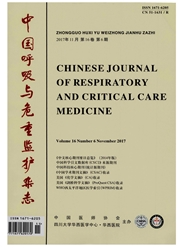

 中文摘要:
中文摘要:
目的探讨肥胖与哮喘控制及气道炎症表型间的关系。方法应用横断面研究方法,前瞻性收集101例哮喘患者临床信息,采用哮喘控制测试(ACT)和GINA哮喘控制标准进行哮喘控制水平评估。测量所有患者身高和体重,并计算体质指数(BMI)。行肺功能检测和痰诱导,对诱导痰和外周血进行细胞分类计数。结果符合研究标准的90例哮喘患者分为正常体重组(n=54)、超重组(n=21)和肥胖组(n=15)。三组间年龄和哮喘发生年龄存在差异(P=0.021和P=0.004)。哮喘控制水平比较,三组间存在明显差异[ACT评分分别为(20.6±2.9)分、(18.6±4.8)分、(18.3±2.9)分,P=0.019;GINA:P=0.014)。相关分析显示,BMI与诱导痰中性粒细胞绝对值呈正相关(r=0.29,P=0.039)。BMI可明显恶化哮喘控制水平[ACT:OR=1.84,95%CI(1.04,3.23),P=0.035;GINA:OR=2.27,95%CI(1.27,4.07),P=0.006],与BMI等级间存在量效关系。经年龄、性别、病程、FEV1%占预计值的百分比、吸烟指数、血中性粒细胞绝对值的校正,肥胖对ACT和GINA控制水平的影响仍然存在统计学意义(P=0.015;P=0.008)。结论在中国人群,肥胖型哮喘呈现以中性粒细胞炎症为主的表型特征,肥胖明显影响哮喘控制水平,且此种效应与BMI存在量效关系。
 英文摘要:
英文摘要:
Objective To explore the relationship of obesity with asthma control and airway inflammatory phenotype. Methods A cross-sectional prospective study was conducted on 101 patients with asthma. Asthma control level was assessed by Asthma Control Test( ACT) and GINA. Furthermore,height and weight were measured and body mass index( BMI) was calculated. Lung function and sputum induction were performed,and differential cell count was obtained from induced sputum and peripheral blood. Results Ninety eligible patients were divided into 3 groups as a normal-weight group( n = 54),an over-weight group( n = 21) and an obesity group( n = 15). The asthma control levels were different among three groups( P = 0. 019 for ACT and P = 0. 014 for GINA,respectively). BMI was positively related to the number of neutrophils in induced sputum( r = 0. 29,P = 0. 039). Increased BMI deteriorated asthma control levels assessed by ACT [OR = 1. 84,95% CI( 1. 04,3. 23),P = 0. 035] and GINA [OR = 2. 27,95% CI( 1. 27,4. 07),P = 0. 006]in a dose-response manner. Obesity indicated poor asthma control assessed by ACT( P = 0. 015) and GINA( P = 0. 008) after adjusting for age,sex,duration of asthma,FEV1% pred,smoking,and the number of neutrophils in peripheral blood. Conclusions In Chinese individuals with asthma, neutrophilic inflammatory phenotype dominates the airway inflammation of obesity-associated asthma. Obesity is a risk factor that deteriorates asthma control level in a significant dose-response manner.
 同期刊论文项目
同期刊论文项目
 同项目期刊论文
同项目期刊论文
 期刊信息
期刊信息
